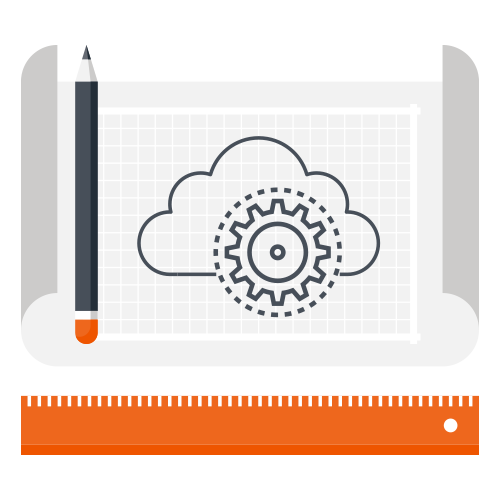More work than ever is taking place using cloud-based resources. Email, applications, file storage, infrastructure, networking – they’re all in the cloud. By shifting IT resources to the cloud, organizations have experienced increases in speed, creativity, innovation, and agility, all while decreasing costs.

That’s why 38% of organizations have made shifting to the cloud their top priority in 2018.
However, it isn’t as easy as snapping your fingers and migrating to the cloud. There are some IT resources that organizations are still going to have on-prem for the immediate future, like network switches, printers, file servers, and laptops or desktop computers.
It’s also no longer a guarantee that employees will even work in an office. So organizations are finding ways to manage on-prem, remote, and cloud environments at the same time. Not surprisingly, it’s difficult to achieve this with traditional IT management tools, but using a never-ending variety of siloed cloud tools is no better.
At the root of the problem is a fractured state of identity. In order to benefit fully from the cloud, IT must centralize their user management, so that each user has one, singular identity for all their critical resources – whether cloud or on-prem. As a result, many IT admins are starting to realize why a cloud identity provider (IdP) should be a top priority if they hope to achieve control over their hybrid environment. After all, no organization is going to leverage the cloud if they can’t feel secure doing so and if they think it will hurt productivity in the long run.

How a Cloud IdP Fosters Prosperity
Tightens Security
With identities being the number one attack vector, an effective identity management solution is central to protect company data. An IdP helps IT organizations gain widespread visibility and control over their environment, and an IdP like JumpCloud® offers standard identity security features like Password Complexity Management, MFA, and SSH key management. JumpCloud in particular can also help you fortify Mac, Linux, and Windows systems with features like Policy Management, system MFA, and Event APIs. These tools allow IT admins to ensure users are accessing resources in a secure manner. As Jon Abbott from Priority One explained, “If you don’t manage the platforms properly, either they’re going to get hacked, or it’s going to be remarkably inefficient. It’s just not going to work if you don’t piece together the right applications and make them actually seamless.” A cloud IdP equips IT admins to bring all of their users, systems, apps, file servers, and networks under one roof, so that they can can achieve the secure, seamless IT environment Abbott describes.

Maximizes Productivity
While modern IT resources like SaaS applications have been shown to reduce meetings and increase customer satisfaction, a cloud identity provider enables end users to efficiently access those resources everyday. This streamlines workflows for users and IT admins alike
Benefits for the End User
A cloud IdP provides users with one set of credentials to access everything they need. This makes it easy for them to remember their password, so they won’t have to waste time regularly resetting it. Not convinced? The LastPass Password Expose report found that the average LastPass user has about 191 passwords. Not only did users waste time typing in all their credentials, but 76% reported regularly experiencing password usage problems. In other words, employees can end up wasting a lot of time just trying to get access to the tools they need to get their work done.

Sadly, access delays can even occur on a new hire’s first day of employment when an organization lacks effective identity management. Nick Laferriere at Tamr reported it used to “take us almost a week to get the developers up and running with accounts and access to developer resources.” After implementing a comprehensive, cloud directory, Nick was able to automate the onboarding process:
“Now, they come on, they fill out the paperwork, and by lunchtime on their first day they have access to everything they need to do their job permanently.”
As you can imagine, passwords and onboarding not only impacts user productivity, but they also affect how IT admins are able to allocate their time.
Benefits for IT Admins
When IT admins can’t give their end users one single, consolidated identity, about 20-50% of support tickets end up being password resets.
A cloud identity provider significantly reduces this, giving IT admins 20-50% more time to work on higher value tasks that help improve the business.
IT admins also don’t have to use so much time provisioning new hires to resources with a cloud identity provider. Features like User and System Groups, the PowerShell module, APIs, and HR integrations have helped organizations reduce the typical hours spent on user management to minutes each week. For example, Paul McKeehan from Saint Thomas Academy found that in the past “Setting up a new faculty user account and provisioning access to all of their resources used to take me an hour or more. With JumpCloud, I can reach the same result in twenty minutes or less.”

Instills Agility
For the modern office, there are thousands of web-based applications, a wide variety of cloud service providers, a mix of systems, and several methods for file storage to choose from. There are so many options available for IT resources, and the list is only going to continue to grow. It really doesn’t make sense these days to impose one set of tools. A cloud identity provider ideally supports this with the ability to connect to IT resources regardless of location, protocol, platform, and provider. So, you will be able to adapt your identity management solution to whatever IT resources make the most business sense. If you need to change your IT resources a year later, no problem. A cloud open directory service will help you securely connect users to those too.

As Juergen Klaassen from Grab said, “We always have to be one step ahead. What’s around the next corner? How can I solve tomorrow’s issue before it becomes a problem? JumpCloud enables us to take on the future with confidence.”
If you plan to harness the full potential the cloud has to offer, don’t waste time trying to make your legacy IT management tools play nice in a hybrid environment. Instead, join the 50,000+ organizations that have shifted to JumpCloud’s open directory service and start experiencing competitive advantages with increased agility, security, and productivity.
Next Steps
Do you still have some questions about why a cloud identity provider should be a priority? Drop us a note, and we’ll gladly answer them. If you’re ready to see JumpCloud Directory-as-a-Service® in action, sign up for a free demo or test it out yourself by signing up for a free account. Your first ten users are free forever.
